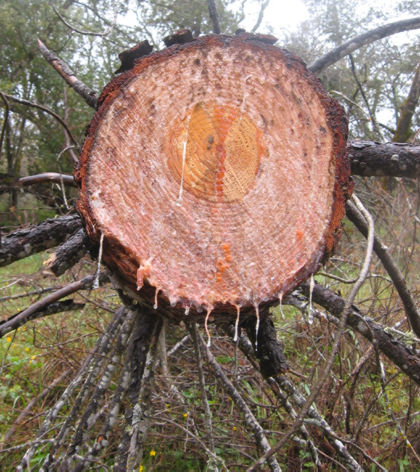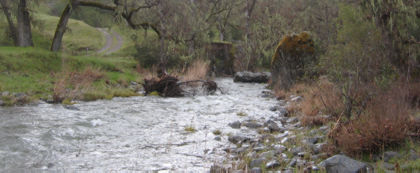Before I get to this week’s hike, I have to revisit last week, when the instructor of my lightweight backpacking class mentioned having gone on a hike that required something like 50 stream crossings. Somebody asked if he changed out of his hiking shoes for all of them and he said heck no: if your shoes have good ventilation, you just slog through the water and let your hike dry them out.
I’m sure there were skeptics in the class — nothing ruins a hike like wet feet. It’s a hassle to change footwear but it’s worth the trouble if the stream crossings are few. I got my leather backpacking boots soaked on day one of a campout last year and it was downright nasty sticking my feet into those damp things the next morning.
But what if you’re covering lots of ground and the stream crossings are many? It’s tempting to cross the creek and suffer the wet shoes. At least you’re crossing tricky terrain in familiar footwear, which adds a safety factor if the water is deep or fast-moving. And if you have a light load — like 20 pounds or less — you can hike in plain old running shoes, which usually have lots of ventilation and will dry out if you hike in them long enough.
I have a nice pair of lightweight trail-running shoes that I could’ve worn yesterday to test out the hike-’em-dry theory but I have a perverse inability to do the obvious thing. Instead, I hiked nine miles in shoes that seemed certain fail the test. Yep, they failed — miserably — but the experiment was a success: now I know which shoes not to take camping with my light pack. A few hours of hiking in the wrong shoes is nothing like a days in the wrong shoes.
The setting for this test was Henry Coe State Park, where I’ve gotten in over my ankles on a fair number of Coyote Creek crossings. The weather would’ve sucked if I’d been hoping to work on my tan, but since I was out there to get my feet wet, it was optimal. (It’s rained almost every day for seven weeks; it’s pouring at this very moment; at least I’ve gotten some good out of it).

Think how much less interesting this picture would be with a gorgeous blue sky distracting you from the all-important oak tree. It’s been a rough spring for trees at Henry Coe; I must’ve scrambled around a dozen fall-downs.

Sometimes you’ll be on a trail at Henry Coe and the view will stop you in your tracks. The hills are not especially high and there are no jaw-dropping peaks jutting up from the horizon. But still, the terrain has an innate ability to astound.

Fresh rainfall gives an amazing sheen to the madrone trees.

The trunk of this fallen tree was cut away to keep the trail open. Remember this scene; it won’t be long before enterprising juvenile delinquents carve their gang symbols in it.

Coyote Creek at Poverty Flat, where I proved the difference between water repellent and watertight shoes. I found relatively shallow (knee-deep), slow-moving places to cross, so the experience wasn’t wasn’t especially harrowing. (For future reference: Unless you’re hiking in hip waders, shoes will become buckets in high water. Footwear lined with a fabric built for keeping water out — think GoreTex — will exhibit an uncanny knack for keeping water in, bringing hours of foot-sloshing pleasure. Mine stayed soaked for four miles past the final creek crossing. Running shoes with lots of mesh will let a lot more water escape, giving them a far greater chance of drying out over the course of an all-day hike).
There is one benefit of getting your feet wet: no longer any need to stress out over keeping them dry.

Tree roots coming up through the rocks. Lord knows how many rainy springs this tree trunk has survived.

The water moves faster in steeper sections of the creekbed. An ant on an oak leaf would get the whitewater-rafting trip of a lifetime here.

A couple young guys out backpacking cross the creek near China Hole. You have to watch your step around here because there’ s low area (the Hole) nearby that’s deep enough for swimming. They made it across fine.

Last time I was here back in November, this was all gravel creek bottom and a few puddles. It’s about knee-deep with a mild current, which encourages such foolishness as standing in the middle of the creek to take its picture. The water starts getting really cold really fast if you linger.

I headed up the Madrone Soda Springs Trail, which has about a dozen creek crossings. Definitely wouldn’t want to be changing in and out of your hiking shoes on this .8-mile stretch of trail.

One of many busted-up trees on the way up to Manzanita Point.

Must’ve made one hell of a "crack" when this section gave way.

Saw this coyote about a mile and a half from the park headquarters. He was just finishing doing that wacky-twist thing canines to do get all the water out of their fur. It’s amazing how much a coyote looks like a dog but seems almost entirely unlike the ones we know as house pets. This is as close as I’ve ever been to one — he was busy trying to dig up a mouse or something and we didn’t notice each other till we were about 15 yards apart. He was kind enough to hang around till I took a few pictures, then trotted off up the hillside.
Rain season’s just about tapped out — days are getting longer and warmer. Wildflowers at Coe are just beginning to appear: I saw a bunch of California poppy plants with orange sprouts that were begging for the sunshine that would give them an excuse to bloom fully. Expect to see much more of Henry Coe this spring.

Ah, a great outing at Henry Coe! Only to get even better soon! I haven’t been there this season yet, but plan to in the upcoming weeks. Great shots, “Mang” of the homeboy coyot’l!! (And others!)